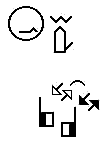Two Notation Systems for Signed Languages: Stokoe Notation & Sutton SignWriting Joe Martin Western Washington University Martinj4@cc.wwu.edu |
||||||||||||
|
STRUCTURE continued...
The example shown in Figure 14, repeated here in Figure 14a, is neither English nor ASL. It is Pidgin Sign, which is only arguably a language at all. To be language there has to be more than words, there must also be a particular grammar. A grammar, in this special linguistic sense, is a specific set of rules that tell how to put words together in one particular language. In English, the grammar requires putting in function words that tell the grammatical relationships, and word endings. It requires that every sentence has both a subject, and a verb that shows tense. On the other hand, the grammars of both ASL and Japanese allow one to omit both subject and tense. Every language has its own unique set of rules. Figure 14 doesn't indicate the grammar of any language, it is just a string of words. Two strings, in fact; one taken from English and written in the Roman Alphabet, and the other taken from ASL and written in both SN and SSW. Without knowing the grammar though, there is no way to tell exactly what these words mean. There are any number of ways to make the English word-string into a proper sentence, and the DASL gives us two of them: "I have just been talking with him," or "I had already talked with him." Each of these two ways draws from the grammar of English and adds a tense ending (-ed, -ing), a subject (I), and several function words. The result is a correct, understandable English sentence. English tends to show its grammar by adding words like this, but ASL has other methods, and tends to use fewer words. For example, it is not necessary to sign "with him" after this ASL verb "talk." This is an "incorporating verb," one which includes both the subject (I) and the object (him). The hands move between the two people talking, clearly showing that the talking is "with" someone, and even telling exactly where that someone is. Rather than meaning "talk" as the gloss suggests, it actually means something more like "(I) conversed with (the specific person in that location)." So this one sign conveys the same meaning as a whole sentence in English. Figure 15 shows the correct sentence in ASL, written in SSW.
The point is that nearly all the word endings, grammatical function words, and other things that change mere word-lists into meaningful statements, signed languages convey through NMGSs (and a knowledge of the language's specific grammar). Scripts that don't take this into account from the very beginning are not capable of writing signed languages. This includes SN, but not SSW.
1. Reported speech: By a slight shift of the shoulders, the
signer takes on the role of a second party, equivalent to the
English "she said" (Liddell 8). This slight shift,
since it means someone else is talking, can change all the pronominal
and other referents in all the rest of the statement. In our
example, the subject of the verb--the person who is talking--changes
from "I" to some other person, even though the sign
doesn't change (Bahan 150). In Figure 16, the tilted bar in the
first character is a "shoulder line," tilted to show
this shift in reference. Figure 16 puts all these into one ASL sentence, a little contrived
perhaps, but grammatically correct. Most of its meaning depends
on an understanding of the grammar of the language and the non-manual
signals. Even though it takes an extremely large number of English
words to translate it correctly, it still uses only the SAME
TWO SIGNS as the earlier simple sentence, and would still be
given the SAME GLOSS. It is widely admitted that the use of English
glosses is inadequate to express sign language, and simply changing
the glosses to ASL is little |
||||||||||||
|
|


